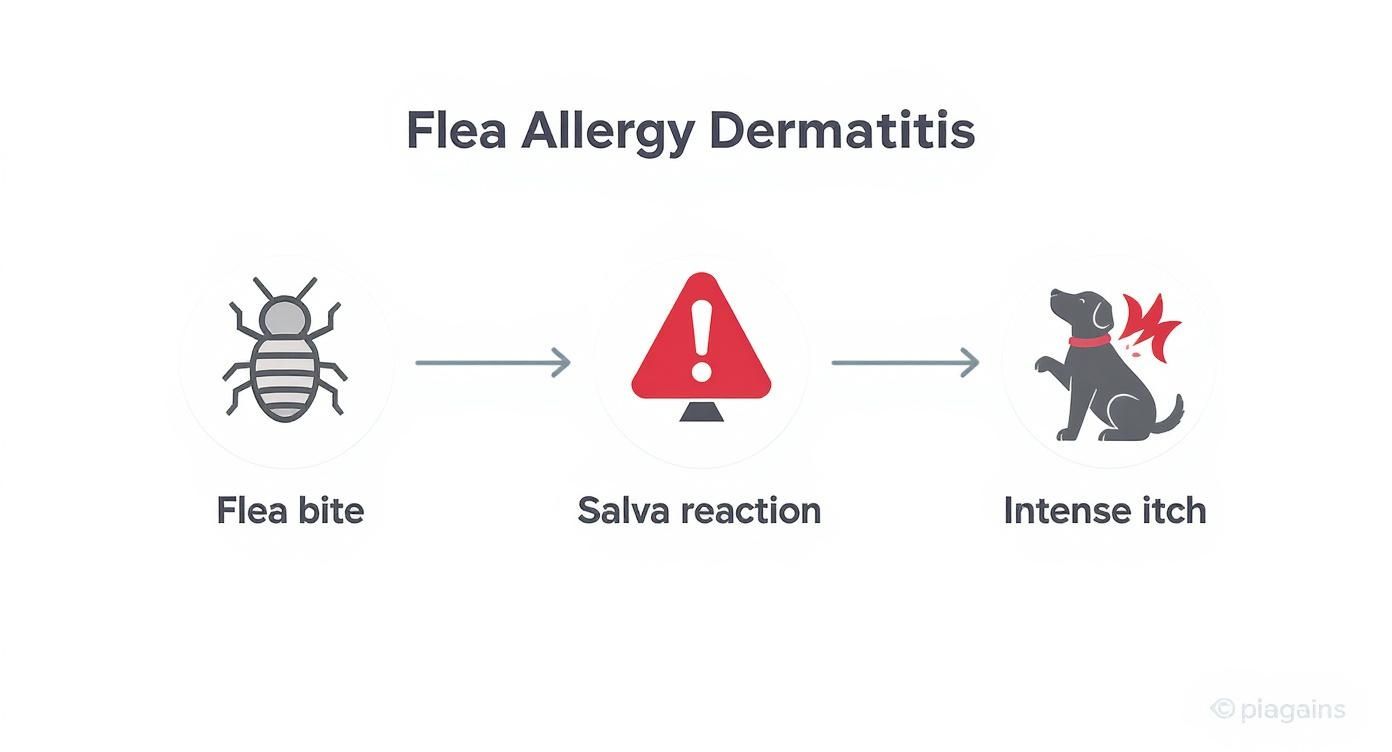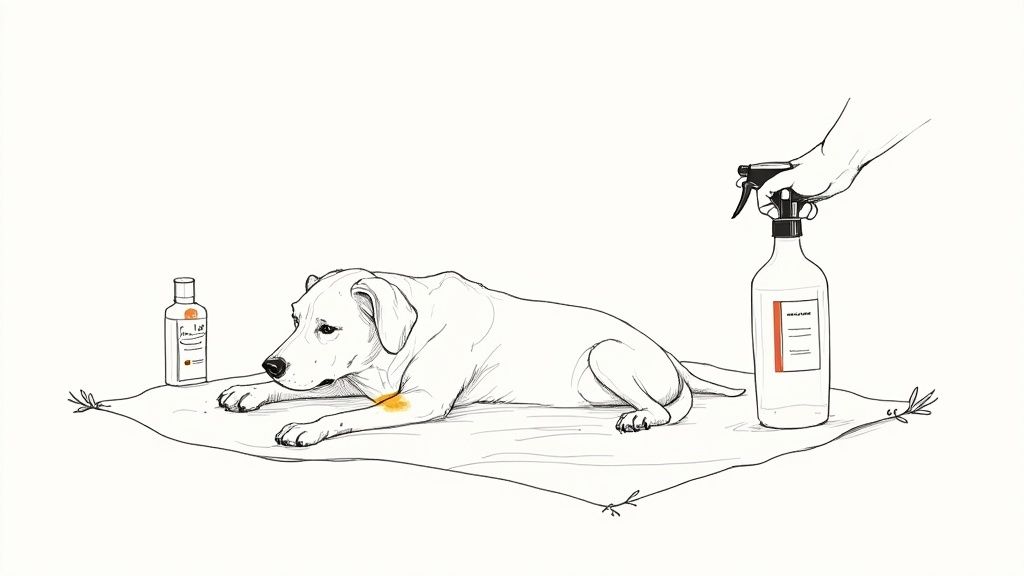When you see your dog constantly scratching but you're certain they don't have fleas, it’s easy to feel stumped. The truth is, that incessant itch often points to something else entirely, like an underlying allergy, painfully dry skin, or even a sneaky skin infection.
These problems can look a lot like a flea infestation and make your dog miserable, but getting to the bottom of it is the first step toward real relief.
Solving the Mystery of Your Itchy Dog

It’s a frustrating scenario for any dog owner. You've combed through their fur, applied the flea treatment, yet the scratching, biting, and licking continues. If this sounds familiar, you're not alone. An itchy dog with no fleas in sight is a common puzzle, and the answer is usually hiding just beneath the surface.
Think of it like a car alarm that keeps going off. The noise – your dog's scratching – is impossible to ignore, but the trigger isn't always obvious. This guide will help you play detective and get to the root cause of your dog's discomfort.
Just because you can't see fleas doesn't mean the itch isn't real. It simply means it's time to dig a little deeper into your dog's environment, diet, and overall skin health to find the real culprit.
We'll investigate a few key areas to figure out what’s going on:
- Hidden Allergies: We’ll explore how common allergens in their food or environment (like pollen or dust mites) can trigger reactions, much like hay fever affects us.
- Skin Infections: Sometimes, a low-grade bacterial or yeast infection can take hold on irritated skin, causing a cycle of itching and scratching.
- Other Parasites: Fleas aren't the only tiny pests out there. We’ll look at less obvious culprits like mites, which can cause serious irritation.
By methodically working through these possibilities, you can stop guessing and start finding a solution that finally brings your furry friend some peace.
The Most Common Causes for Constant Itching

So, you've checked for fleas, and there's not a single one in sight, but your dog is still scratching like mad. What gives? More often than not, the culprit is an overactive immune system kicking off a reaction to something in their environment, their food bowl, or even on their skin. Getting to the bottom of these triggers is the first real step towards giving them some relief.
It’s a surprisingly common issue here in the UK. A huge number of dogs suffer from chronic itching even when they’re completely flea-free. In fact, it's estimated that around 10% of dogs in the UK have allergies that lead to this kind of intense scratching. This isn't some rare problem; it’s a widespread issue usually pointing to one of a few key culprits.
Environmental Allergies and Atopic Dermatitis
One of the most common reasons for a dog constantly scratching is atopic dermatitis. Think of it as the doggy equivalent of hay fever. But instead of sneezing and watery eyes, their main symptom is incredibly itchy skin.
This is a reaction to airborne allergens that your dog either breathes in or absorbs through their skin. The usual suspects include:
- Pollen from grass, trees, and weeds
- Dust mites hiding out in your carpets and their bedding
- Mould spores that love damp spots around the house
When your dog encounters these, their immune system goes into overdrive, causing inflammation and that non-stop itch. You'll often see it flare up around their paws, ears, and belly. Learning the other signs of dog allergies can help you connect the dots.
Food Sensitivities and Allergies
What’s in your dog’s dinner bowl could also be the source of their discomfort. Unlike environmental allergies that often come and go with the seasons, a food sensitivity can cause relentless, year-round itching. It’s often triggered by common proteins like beef and chicken, or sometimes dairy and wheat.
Here's the tricky part: a food allergy isn't usually an instant reaction. It's a slow burn. A dog can suddenly develop a sensitivity to a food they've been eating happily for years, which makes it a real puzzle to solve without a proper elimination diet guided by your vet.
Skin Infections and Dry Skin
Sometimes, the scratching itself kicks off a whole new problem. All that irritation from an allergy can break down the skin's protective barrier, which is like rolling out the welcome mat for secondary infections. Both bacterial and yeast infections love to set up shop on inflamed skin, creating a vicious cycle of itching, scratching, and more skin damage.
On the flip side, the cause could be as simple as dry skin. Just like us, dogs can get dry, flaky, and itchy skin, especially during the winter when the central heating is on full blast. This lack of moisture can lead to a nagging, low-grade itch that keeps them scratching all day and night.
To help you get a clearer picture, here's a quick breakdown of these common itch-inducers.
Quick Guide to Non-Flea Itch Causes
Use this reference table to quickly compare the common causes of itchiness, their typical symptoms, and potential triggers for a preliminary assessment.
| Cause | Key Symptoms | Common Triggers |
|---|---|---|
| Environmental Allergies | Seasonal itching, chewing paws, ear infections, red belly. | Pollen, dust mites, mould spores. |
| Food Allergies | Year-round itching, digestive issues (sometimes), skin infections. | Common proteins (chicken, beef), dairy, wheat. |
| Skin Infections | Sores, scabs, hair loss, unpleasant odour, greasy or flaky skin. | Secondary to allergies, moisture, damaged skin. |
| Dry Skin | Flaky skin (dandruff), dull coat, generalised itchiness. | Low humidity, poor diet, excessive bathing. |
This table can act as a starting point, helping you notice patterns in your dog's behaviour and symptoms before you have a chat with your vet.
The Flea Allergy You Can't See
It’s one of the most common frustrations for dog owners: your dog is scratching like mad, but you can’t find a single flea on them. This often points to a sneaky condition called Flea Allergy Dermatitis (FAD), which is less about a full-blown infestation and more about a severe allergic reaction.
Think of it like a person with a bad mosquito bite. For some, it's a minor annoyance. For a highly sensitive person, that one bite can swell up into a huge, incredibly itchy welt. FAD works the same way for an allergic dog – it only takes a single bite from one flea to set off a chain reaction of intense, widespread itching that can last for weeks.
This is why the "no fleas" observation can be so deceptive. A flea could easily jump on, bite, and jump right back off, leaving a trail of misery in its wake. The intense allergic response continues long after the tiny culprit has vanished, making it seem like the scratching has appeared out of thin air.
Telltale Signs of FAD
If your dog is dealing with FAD, the itching is usually frantic and focused, not just a casual scratch behind the ears. Keep an eye out for specific clues that point towards this powerful allergy:
- Intense chewing, licking, and scratching, especially around the lower back, the base of the tail, and down their back legs.
- Patches of hair loss in these target areas from the constant irritation.
- Red, inflamed skin, scabs, or even "hot spots" where the skin has become broken and infected.
This isn't a rare problem. In fact, research suggests Flea Allergy Dermatitis affects an estimated 250,000 or more dogs across the UK. It’s all down to an overactive immune system that goes into overdrive in response to proteins in flea saliva. You can read more about just how common FAD is from this in-depth article about flea allergies.
The key takeaway is this: for an allergic dog, one bite is an emergency. The discomfort is completely out of proportion to the cause, which is why consistent, year-round flea prevention is absolutely non-negotiable.
Realising this hidden trigger is a game-changer. It shifts the focus from simply soothing the itch to preventing the bite from ever happening. For more advice, check out our guide on how to treat dog allergies effectively.
How Your Vet Will Diagnose the Itch
When your dog can't stop scratching and you're sure it's not fleas, a trip to the vet is your next best move. Knowing what to expect during the visit can help ease any anxiety for both you and your furry friend. Think of your vet as a detective; they'll start with the most likely suspects and work their way down the list to solve the mystery of the itch.
The whole process kicks off with a detailed physical exam. Your vet will carefully check your dog's skin and coat from nose to tail, looking for tell-tale signs like redness, rashes, bald patches, or any secondary infections that might have developed from all the scratching. They’ll also ask you plenty of questions about your dog's daily life—what they eat, where they play, and their general history—to start gathering clues.
Common Diagnostic Tests
To dig a bit deeper, your vet will likely suggest a few common tests. These procedures are designed to methodically rule out potential causes until they can zero in on the real culprit behind your dog's discomfort.
- Skin Scrapes: This sounds worse than it is! It's just a simple, painless scrape of the skin's surface that gets put under a microscope. This is the best way to spot microscopic critters like mites, which can cause conditions like mange and are completely invisible to the naked eye.
- Cytology: Your vet might use a bit of sticky tape or a glass slide to collect a sample from your dog's skin. This lets them check for an overgrowth of yeast or bacteria, which often jump at the chance to cause trouble on already irritated skin.
- Allergy Testing: If your vet suspects an environmental allergy, they might recommend a blood test or refer you to a specialist for intradermal skin testing. These tests help pinpoint specific triggers, such as certain pollens, moulds, or dust mites.
When it comes to food allergies, the most reliable diagnostic tool is an elimination diet. This involves switching your dog to a strict, novel protein diet for 8-12 weeks. If the itching subsides, it's a strong indicator that something in their old food was causing the problem.
This infographic shows just how much trouble a single flea bite can cause for an allergic dog.

It’s a great reminder that the problem often isn't an infestation, but a severe allergic reaction to the saliva from just one bite.
Finding Relief: How to Soothe Your Dog's Itchy Skin

Once you and your vet have figured out why your dog is scratching so much, the real work begins: finding the right approach to bring them some much-needed relief. Getting on top of itchy skin isn't usually about a single "cure"; it’s more about a combination of professional treatments and smart, supportive care you can provide at home. This partnership is what finally breaks that miserable itch-scratch cycle.
Your vet has an arsenal of modern medications that can stop the itch in its tracks. These might include immunomodulatory drugs that calm down the overactive immune response at the heart of an allergy. For a quick fix during a bad flare-up, they might suggest a short course of steroids or traditional antihistamines to get the inflammation under control and give your dog a break.
At-Home Support and Topical Care
What you do at home is just as important as what happens at the clinic. Applying treatments directly to your dog’s skin provides targeted, immediate comfort right where they need it most.
This hands-on care can look like:
- Medicated Shampoos: Your vet might prescribe a specific shampoo to calm inflammation, tackle any secondary skin infections, or simply add moisture back into dry, flaky skin.
- Soothing Sprays and Mousses: These are brilliant for managing problem areas or "hot spots" between baths, offering a quick cooling sensation.
- Regular Bathing: Don't underestimate the power of a good bath. A 2020 UK survey noted that while over 86% of dogs got regular flea treatments, 52.9% were also bathed at least once a month. Vets often encourage this, usually with a gentle, oatmeal-based shampoo to wash away allergens and soothe the skin. Find out more about the science behind bathing and skin health in dogs.
Think of topical care as repairing the skin's natural barrier. A healthy skin barrier is like a well-maintained roof—it keeps moisture in and allergens out, preventing problems before they can even start.
Building Healthy Skin from the Inside Out
A dog's diet is the foundation of their overall health, and that absolutely includes their skin. The right nutrients can build up the skin's resilience from within, making it far less prone to reacting to triggers.
A fantastic starting point is adding omega-3 fatty acids to their food. Found in things like fish oil, these healthy fats are well-known for their anti-inflammatory properties and ability to support a strong skin barrier.
Simple changes around the house can also have a surprisingly big impact. Swapping to hypoallergenic bedding, hoovering frequently to cut down on dust mites, and giving your dog’s paws a quick wipe after a walk can significantly reduce their exposure to allergens.
These small, consistent efforts add up, providing real relief for a dog who's constantly scratching. For more great ideas, have a look at our guide on dog itching home remedies.
Got Questions About Your Dog's Itching?
When your dog can't stop scratching and you've ruled out fleas, it's natural to have a million questions. Trying to figure out what's going on with your dog's skin can feel overwhelming, so let's tackle some of the most common queries we hear from worried owners.
Getting to the bottom of your dog’s itch is a process, but a little knowledge can make you a more confident partner in their care when you chat with your vet.
Can I Just Give My Dog Piriton for the Itching?
It's a tempting thought, but you should never give your dog human medications without your vet's explicit instruction. While some antihistamines are used in veterinary medicine, the dose and type are critical. The wrong one could do more harm than good, or simply not work at all. Your vet is the only one who can decide if an antihistamine is the right move and prescribe a safe product and dose for your dog.
How Long Does a Food Elimination Diet Really Take?
This is a marathon, not a sprint! A proper food elimination trial needs a strict commitment for at least 8 to 12 weeks to get clear answers. For this to work, your dog can only eat the special diet your vet recommends—that means zero treats, no table scraps, and no flavoured supplements. It sounds tough, but this level of discipline is the only way to know for sure if a food sensitivity is the culprit behind all that scratching.
Could My Dog Just Be Scratching Out of Stress?
Absolutely, this is a real possibility. Sometimes, obsessive scratching, licking, or chewing is a behavioural habit, a condition known as psychogenic alopecia.
But here’s the important part: vets treat this as a "diagnosis of exclusion." This means they must first do a full investigation to rule out every other medical cause—like allergies, parasites, or infections—before landing on stress as the reason.
If it does turn out to be behavioural, the solution will involve things like behaviour modification and making their environment more engaging. Pinpointing the true source of your dog's discomfort is a team effort with your vet, requiring patience and a step-by-step approach.
At Tipaw, we know that happy skin is supported from the inside out. Our range of vet-approved, natural supplements is formulated to strengthen your dog's skin barrier and soothe irritation, helping them get back to a comfortable, itch-free life. Discover our skin and coat solutions at https://www.store-tipaw.com.





